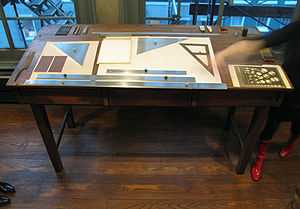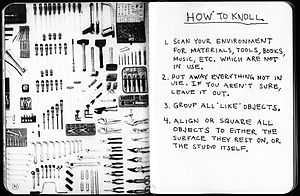Knoll (verb)

Knolling is the process of arranging related objects in parallel or 90 degree angles as a method of organization.
Origin
The term was first used in 1987 by Andrew Kromelow, a janitor at Frank Gehry's furniture fabrication shop. At the time, Gehry was designing chairs for Knoll, a company famously known for Florence Knoll's angular furniture. Andrew Kromelow would arrange any displaced tools at right angles on all surfaces, and called this routine knolling, in that the tools were arranged in right angles—similar to Knoll furniture.[1] The result was an organized surface that allowed the user to see all objects at once.
The American sculptor Tom Sachs spent two years in Gehry's shop as a fabricator and adopted use of the term from Kromelow. Nowadays, knolling is integral to his process.[2] Sachs adopted the phrase "Always be Knolling" (abbreviated as ABK) as a mantra for his studio (in direct reference to Blake's infamous "Always be Closing" in Glengarry Glen Ross), which he expands on in his 2009 studio manual, 10 Bullets:
BULLET II: ALWAYS BE KNOLLING (ABK)
- Scan your environment for materials, tools, books, music, etc. which are not in use.
- Put away everything not in use. If you aren't sure, leave it out.
- Group all 'like' objects.
- Align or square all objects to either the surface they rest on, or the studio itself.

Knolling is present in Sachs' oeuvre in pieces like Hardcore, a cabinet filled with objects neatly arranged at right angles. He has also had a long-time obsession with Knoll furniture, most evident in pieces like Knoll Loveseat and End Table (currently at the San Francisco Museum of Modern Art) and Barcelona Pavilion, both full-scale replicas of Knoll furniture by the same name.
See also
External links
- Tom Sachs' video, "Always be Knolling"
- Tom Sachs official website
- Knoll official website
- Things Organized Neatly (blog)
- Humorous satire of knolling on late night TV-Show
Notes
References
- Celant, Germano. 2006. Tom Sachs. Fondazione Prada. ISBN 88-87029-37-7
- Fleming, Jeff. 2007. Logjam. Des Moines Art Center. ISBN 978-1-879003-49-1.
- Sachs, Tom. 2009. Ten Bullets. Allied Cultural Prosthetics. ISBN 978-0-9790499-8-9.
- Sachs, Tom. 2010. Unacceptable Behavior. Allied Cultural Prosthetics. ISBN 978-0-9828372-0-7.